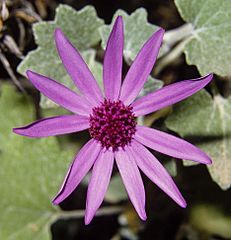Pericallis lanata facts for kids
Quick facts for kids Pericallis lanata |
|
|---|---|
 |
|
| In habitat, Masca, Tenerife | |
| Scientific classification | |
| Synonyms | |
|
Pericallis lanata is a special kind of flowering plant that belongs to the Asteraceae family. This family is also known as the daisy or sunflower family. This plant is unique because it only grows in one specific place in the world: the Canary Islands. When a plant or animal only lives in one area, it's called "endemic."
Contents
What is Pericallis lanata?
Pericallis lanata is a beautiful plant that produces many flowers. It is part of a large group of plants that share similar features, like how their flowers are arranged. The name lanata comes from a Latin word meaning "woolly." This is because parts of the plant, especially its leaves, often have a soft, fuzzy, or woolly texture.
Why is it called "lanata"?
The "lanata" part of its name describes a key feature of this plant. Many plants that grow in dry or sunny places have fuzzy leaves. This fuzz helps them in a few ways. It can protect them from too much sun. It also helps them hold onto water. This is very important for plants in places like the Canary Islands.
Where Does Pericallis lanata Grow?
This plant is native only to the Canary Islands. These islands are located in the Atlantic Ocean off the coast of Africa. The Canary Islands have a unique climate. They are often sunny and can be quite dry. Pericallis lanata has adapted perfectly to these conditions.
Its Natural Home
You can find Pericallis lanata growing in rocky areas. It often grows on cliffs or slopes. These places can be tough for many plants. But Pericallis lanata thrives there. It prefers areas with good sunlight. It also needs soil that drains water well. This means water does not sit around its roots.
What Does Pericallis lanata Look Like?
Pericallis lanata is known for its attractive flowers. These flowers grow in groups called flower heads. Each flower head looks like a single large flower. But it is actually made up of many tiny flowers. This is a common feature of the daisy family.
Leaves and Stems
The leaves of Pericallis lanata are often green or grayish-green. They can have that distinctive woolly texture. This fuzziness helps the plant survive in its environment. The stems are usually strong. They help the plant stand upright. This allows its flowers to reach the sun.
The Flowers
The flowers of Pericallis lanata are usually bright and colorful. They can be various shades, often purple or blue. Sometimes they might be white or pink. These colors help attract pollinators like bees and other insects. Pollinators are important for the plant's reproduction.
Life Cycle and Reproduction
Like all flowering plants, Pericallis lanata goes through a life cycle. It starts from a seed. Then it grows into a mature plant. Finally, it produces its own seeds. This cycle allows the plant to continue its species.
How it Reproduces
Pericallis lanata reproduces using its flowers. The flowers produce pollen and ovules. Pollen is carried from one flower to another. This can happen by wind or by insects. When pollen reaches an ovule, a seed can form. These seeds will then grow into new plants.
Seeds and Spreading
After the flowers are pollinated, they produce seeds. These seeds are often small and light. They can be carried by the wind. They might also stick to animals. This helps the plant spread to new areas. It ensures that new plants can grow in different spots.
Importance of Pericallis lanata
Every plant plays a role in its ecosystem. Pericallis lanata is part of the unique plant life of the Canary Islands. It adds to the biodiversity of the region. Biodiversity means having many different kinds of living things.
Part of the Ecosystem
This plant provides food or shelter for insects. It helps to prevent soil erosion on slopes. It is also a beautiful part of the natural landscape. Protecting plants like Pericallis lanata is important. It helps keep the natural world healthy.
See also
 In Spanish: Pericallis lanata para niños
In Spanish: Pericallis lanata para niños


